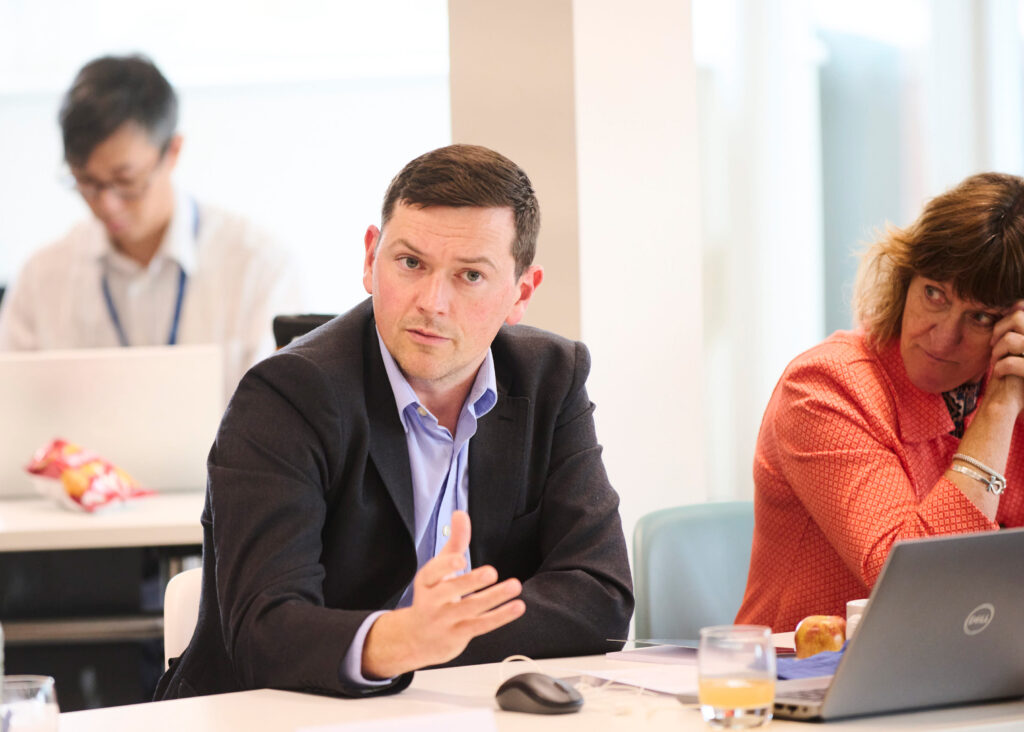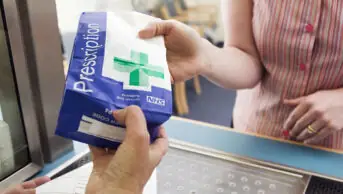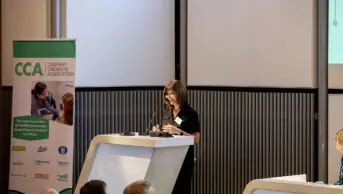
Paul Stuart
Fostering a culture of learning within a multidisciplinary team will be crucial to the development of pharmacists joining the register as independent prescribers from 2026.
This was the overarching message of a roundtable meeting hosted by The Pharmaceutical Journal on behalf of the Royal Pharmaceutical Society (RPS) at its London headquarters.
The event brought together a panel of stakeholders (see Box) to discuss the current position and work underway across Great Britain (GB) to implement changes made to the initial education and training standards by the General Pharmaceutical Council (GPhC) in January 2021. The updated standards will enable pharmacists to independently prescribe from the point of registration by 2026.
The roundtable meeting, held on 18 July 2023, sought to identify potential ways to support these pharmacists after receiving their qualification.
Opening the discussion, co-chair Michael Dowdall, executive editor for research and learning at The Pharmaceutical Journal, highlighted that pharmacist independent prescribers are already “ensuring the safe and effective use of medicines across a wide therapeutic and clinical spectrum”. While the number of pharmacist independent prescribers has increased rapidly in recent years, rising to 16,330 pharmacist independent prescribers as of June 2023, accounting for 26% of the register, results from The Pharmaceutical Journal’s 2022 salary and job satisfaction survey show there is considerable variation in how pharmacists across sectors are currently using their prescribing qualification in practice.
The survey showed that, of 470 independent prescribers from across the UK, just over half prescribe daily. However, 18% prescribed less than once per year or had never prescribed.
Most of those who had never prescribed work in community pharmacy, while daily prescribing was most common for primary care pharmacists. Across sectors, lack of opportunity was the most cited reason (47% n=104) for individuals not using their prescribing qualification. However, lack of confidence and access to medical records were also cited as contributory factors.
These figures highlight the cultural changes needed by the profession for newly qualified independent prescribers to make the best use of their qualification, both for themselves and their patients. “Unless we get the initial education and training standards right to give them confidence, we’re at risk of them not using the qualification,” said Kathryn Hodgson, associate dean at Health Education and Improvement Wales, who also highlighted the importance of understanding “what the patient expectations are” at the roundtable.
However, any changes will require support from a variety of stakeholders, said Ailsa Power, associate postgraduate pharmacy dean at NHS Education for Scotland, adding that other healthcare professionals, and even some pharmacists, are not fully aware of the GPhC’s new standards and the implications they have. “The RPS, as our leadership body, has a big role in marketing the message of what’s happening,” she said, “not just for healthcare professionals, but for patients as well.”
Box: Definitions
Designated prescribing practitioners (DPP): Healthcare professionals with legal prescribing rights, who mentor and supervise a pharmacist during their prescribing training in practice.
Designated medical practitioners (DMP): A medical practitioner who directs and supervises a non-medical prescriber during their prescribing training in practice, similar to a DPP.
Prescribing scope of practice: Prescribing activities a healthcare professional carries out within their professional role. The healthcare professional must have the required training, knowledge, skills and experience to deliver these activities lawfully, safely and effectively.
Clinical checks: These are made before medicines are prescribed, supplied or administered, and involve the identification of potential pharmacotherapeutic problems by gathering and evaluating all relevant information, such as patient characteristics, medication regimen and laboratory results.
Clinical supervision: This involves a senior colleague providing guidance and feedback to a trainee or junior colleague to develop and assess their clinical skills competence.
Multidisciplinary teams: Teams of healthcare professionals from different organisations and professions who work together to decide on how to treat their patients.
Lessons from across Great Britain
In his introductory remarks, Dowdall noted the “differences across the GB nations, particularly in community pharmacy” in how independent prescribing qualifications are being used.
To reflect this, members of the panel provided updates on how independent prescribing services are developing in a variety of sectors across the three nations.
Wales
Karen Hodson, personal chair and director for the postgraduate-taught professional programmes and continuous professional development at Cardiff University, presented data highlighting the success of the Community Pharmacy Independent Prescribing Service.
A pilot of the service launched in June 2020, allowing pharmacists to prescribe for a range of conditions, including ear, skin, urinary tract and upper respiratory tract infections, as well as contraception. Between May 2022 and May 2023, there were 63,278 pharmacist consultations, 118 pharmacist users and 135 pharmacy sites registered for the service.

Paul Stuart
Hodson said that the inclusion of independent prescribing as a priority in government strategies, such as ‘Pharmacy: Delivering a Healthier Wales’, has contributed to the success of the service.
Hodson also gave an update on the Welsh hospital pharmacy review in the context of independent prescribing, which is due to be published in September 2023.
Scotland
Roisin Kavanagh, director of pharmacy at NHS Ayrshire and Arran, provided an update on the use of independent prescribing in Scotland, highlighting that nearly half (49%) of those with an independent prescribing qualification are actively prescribing — an increase from 31% in 2021.
Kavanagh said Scotland’s ‘Teach and treat’ model has effectively bridged the gap between having an independent prescribing qualification and using it. The model sees experienced community pharmacist prescribers guide those with less experience as “a way of supporting them to gain that confidence and to use that prescribing qualification”.

Paul Stuart
Fiona Stewart, associate postgraduate pharmacy dean at NHS Education for Scotland, added that pharmacists using the model “do a bit of self-assessment” to identify areas that they need help with and the teach and treat hub lead will offer appropriate patients for them to see in the hub or “staff members who will roleplay”.
However, Kavanagh noted particular difficulties with the number of designated prescribing practitioners (DPPs). “I think the challenge at the moment is certainly the number and availability and geographical spread of those DPPs,” she said, adding that, in 2022, Scotland only had 100 pharmacist DPPs, which meant “only a third had access to a pharmacist as their DPP and the rest were relying on medics”.
The availability of DPPs was also raised as a concern by William Swain, lecturer at University College London School of Pharmacy and prescribing integration project lead at South East London Integrated Care System, who said that “there are not many prescribers stepping forward with the confidence to be a DPP”, adding that this emphasises the importance of empowering the current independent prescribing workforce.
England
Anne Joshua, head of pharmacy integration at NHS England, provided an update on the ‘Community pharmacy independent prescribing pathfinder programme’.
The programme will be the first nationally-commissioned service through which pharmacists will be able to use their independent prescribing qualification in England. In her presentation, Joshua highlighted the importance of investing in digital infrastructure.
“It is the GP-held record at the moment that will give the best clinical assurance around activity related to long-term condition support,” said Joshua, adding that giving pharmacies access to the GP Connect system will enable pharmacists “to view straight through to the GP record to see test results and patient observations”.

Paul Stuart
“This will be an asset to those offering blood pressure checks and the Community Pharmacy Consultation Service, in addition to prescribing services,” she said. Access to GP Connect will also enable pharmacists to input information directly into the GP record having completed a consultation.
Closing the discussion around the progress made in independent prescribing services across GB, Hodson said it was encouraging to hear that there is “some alignment” between the three nations.
However, it was also acknowledged that enabling pharmacists to provide these services would require significant support from the pharmacy profession and wider NHS.
Ways to support newly qualified pharmacist independent prescribers
Supporting early prescribing with clinical checking
Box: Panel suggestions
- Use the ‘teach and treat’ model to help pharmacists gain confidence in prescribing post qualification;
- Give prescribers access to both formal and informal clinical supervision as prescribers will need to be able to discuss their clinical reasoning and decision making.
Panellists noted that research has shown pharmacist prescribers are more risk averse and more likely to prescribe within guidelines than other healthcare professionals, resulting in lower error rates, raising questions around whether pharmacist-generated prescriptions need to be checked.
“If the error rate of pharmacist prescribers is 0.3–0.6%, then it is not good use of public money to pay another pharmacist to check that prescription,” said Nick Haddington, pharmacy dean for southwest England at NHS England’s Workforce, Training and Education directorate.
However, Kavanagh said: “We are more risk averse compared with other prescribers and that can be a good thing but can also hold us back. So how do we support people to think a bit differently?”
There was a consensus that pharmacy technicians are well placed to carry out clinical prescription checking, with Amy Laflin, director for education at the Association of Pharmacy Technicians UK, saying that using pharmacy technicians in this way “will release the pharmacists to be able to do the prescribing”.
Learning within a multidisciplinary team
Box: Panel suggestions
- Use the varying skillsets within a multidisciplinary team (MDT) to develop clinical reasoning and in cases of diagnostic uncertainty;
- Use MDT-collaborative prescribing to outsource clinical decision making to other members of the MDT, narrowing pharmacist trainees’ scope of practice initially and allowing them to focus on prescribing;
- Leverage simulation technology, particularly for undergraduates to give them exposure to the MDT and areas of prescribing complexity. However, there was some concern that while useful for patient safety, it is not directly comparable to real-life clinical settings.
Hodson stated that “pharmacist prescribing will not happen unless we have got good working in multidisciplinary teams and good relationships with the other healthcare professions”.
In answer to this, Swain presented early findings from a ‘prescribing integration project’ that is ongoing at South East London Integrated Care System, which aims to use MDTs to support newly qualified pharmacists with prescribing, instead of solely relying on DPPs.
“I think that then removes a barrier, because if we’re teaching our trainees how to communicate and leverage the MDT, that’s a much more discreet training model,” Swain said, adding that the MDT can be used for diagnostic and other clinical decision making, allowing a narrower scope of practice initially.
“I’m much of the view that more time and more prescribing doesn’t make you more confident as a prescriber; it’s all about supervision and working closely with another member of the MDT who’s perhaps a bit further down that journey [and] can really help emancipate and empower these novice prescribers,” said Swain.
While an MDT approach may not be suitable for community pharmacy currently, Swain said that it would be feasible in secondary care, where pharmacists could be prescribing regular medicines as part of the medicines reconciliation process, or making dose adjustments with small medicines optimisation-type tasks, “and then also prescribing under the direction of a consultant”.
However, Joshua questioned whether “there is an opportunity here for people that are specialists and pharmacist specialists in certain areas to go out into the community”.
Lawrence Brad, GP partner at Westbourne Medical Centre in Poole Bay and Bournemouth Primary Care Network (PCN), also suggested leveraging the MDT for diagnostic decisions in primary care. “There’s a lot of people in the MDT much better placed to make a diagnosis, and where pharmacists are brilliant is when there is a diagnosis,” he said.
However, Haddington pointed out that community pharmacy prescribing services in Scotland and Wales are undifferentiated presentation settings. “The ability to make novel diagnoses is a core capability and competence that pharmacists need to have,” he said.

Paul Stuart
Haddington said that NHS England, in collaboration with partners in Scotland, Wales and the Pharmacy Schools Council, is developing the foundation training programme and the joint curricula to create “a continuum of education” throughout the initial five years of education. This will look at “prescribing skills to develop those capabilities and clinical reasoning as being a really central fundamental tenet,” he said.
Establishing a culture of learning
Box: Panel suggestions
- Standard scope of practice documents across job roles (for both prescribers and non-prescribers) that are reviewed on an annual basis. They should defines an individual’s scope of practice and what they are responsible for, and indicate how that person would like to develop in the future;
- Spread the induction load to prioritise other parts of the onboarding process, so that pharmacists are not prescribing on their first day;
- Establish formalised peer-to-peer support networks, with the RPS potentially taking the lead on this;
- Use informal channels, such as Microsoft Teams and WhatsApp, as judgement-free forums to ask questions or reflect on difficult situations;
- Universities and other education providers should introduce the concept of peer-to-peer support earlier to get pharmacists used to reflecting on their experiences;
- Use virtual technologies to link pharmacists; for example, community pharmacists, who may be more isolated owing to their work environments.
The panel agreed that using peer-to-peer support to foster a culture of openness when prescribing is important.
Hazel Kirwin, advanced clinical pharmacist — medication safety in diabetes and endocrinology at Newcastle upon Tyne Hospitals NHS Foundation Trust, noted how crucial it is for governance and medicines safety to “create that kind of safety net feeling, like you can talk about when something didn’t go right”.
“There has been a vacuum of people seeking peer-to-peer support, these kinds of WhatsApp groups have risen organically,” said Rhodri Thomas, associate director contractor engagement at Community Pharmacy Wales. “They’re great — sometimes you do need a bit more structure around it, because they can become echo chambers.”
However, Haddington warned that these channels can become too formalised. He said: “The more formal the clinical supervision process or intervention, the less safe it feels, because the more it feels as if they might be being tested and they will want to expose themselves less, related to things that they’re uncertain about.”
Haddington also said it should be a priority “to describe what clinical supervision is, what its use is, what its utility is and how it can help people”.
“Each person needs to have sessions with clinical supervision,” he said. “That doesn’t mean that they need to have time set with someone next to them watching what we’re doing, and directly observing, it means that they need to have the opportunity for appropriate peer [or] professional support, which is clinical supervision.”
Haddington also noted that peer discussion is now part of the revalidation process, saying “my impression is that that step was made purposefully, to try to indicate the importance that they place on clinical supervision, elements and practice”.
Demonstrating competence and progression
Box: Panel suggestions
- Use ‘Miller’s triangle’, which divides the development of clinical competence into four levels: knowledge, application of knowledge, clinical skills competency and clinical performance;
- Assessment on whether GPhC revalidation is enough for assessing prescribing competence in different sectors is required;
- Progressing pharmacists through treating patients with increasingly challenging conditions; for example, from treating healthy, young patients to those with complex multimorbidity;
- Measure progression in community pharmacy by the types and complexities of the private services they provide;
- Use prescribing data to analyse prescribing trends and identify areas for improvement.
Brad suggested benchmarking a prescribing pharmacist against the complexity of patients and services that they are experienced enough to manage as a way of demonstrating both competence and progression across primary and secondary care. For example, a prescriber will likely not be asked to cover intensive therapy units or oncology until they have senior supervision and develop expertise, he said.
Hodson questioned who should be assessing competence across sectors: “If you want a system for community pharmacists, if they’re a locum, or if they have their own pharmacy, then who’s going to look and check it from there?”
There was consensus in the room that using something similar to the prescribing assessment, which focuses on appropriate medicines selection and is undertaken by doctors in their foundation year, would not be appropriate as it does not assess the relevant competencies.
Independent prescribers need to be able to demonstrate many more skills than prescribing, said Hodson. “It’s the history taking, it’s about the attributes and the behaviours, it’s about shared decision making. There’s so much more than just choosing the appropriate medicine to prescribe.”
Existing tools and resources
Box: Panel suggestions
- Provide online learning events within trusts that are conducted over Microsoft Teams or Zoom, which can be shared with community pharmacists;
- Use formularies and prescribing templates used in general practice, which allow for a level of protection;
- Use systems, such as AccuRx, which provide a safety net for sending patient medicine information and ensuring they have received it;
- Use supervised learning tools for feedback as a validated mechanism for providing reflection on capability and development;
- Use entrustable professional activity assessment scales, which allow for competency-based decisions according to the level of supervision required;
- Using the credentialing framework as a reference point to enable pharmacists to develop themselves professionally;
- Use polypharmacy indicator tools as in general practice to inform clinical decision making;
- Use clinical decision aids, such as those produced by the National Institute for Health and Care Excellence, to help pharmacists communicate with patients;
- Provide protected learning time, while accounting for neurodiversity of a particular individual.
There was some disagreement between the panel on the ways in which protected learning time should be offered. Nick Thayer, head of policy at the Company Chemists’ Association, said that “each individual has entirely different bespoke requirements for what learning they need, how they access it, and how much they need”.
Thayer continued: “Trying to define it at a national level, or even any kind of employer level, is incredibly difficult, and you end up running risks of shoehorning people into things that don’t make any sense and it becomes a form of tick boxing.”
In concluding the day, Beth Ward, former associate director of education at the RPS, said the society is “about to embark on a massive project to bring together all the strands across the RPS who are focused on prescribing”.
“This is really the start of that journey of starting to bring this conversation out to the masses,” she said.
Dowdall concluded the meeting by thanking everyone for attending, particularly to those who presented, and for starting the conversation that will help define solutions to the support requirements of new prescribers come 2026.
Box: Expert panel members
Lawrence Brad, GP partner, Westbourne Medical Centre, Poole Bay and Bournemouth Primary Care Network
Nick Haddington, pharmacy dean, South West, NHS England Workforce, Training and Education
Kathryn Hodgson, associate dean — head of CPD programme delivery and post-registration foundation practice (pharmacy), Health Education and Improvement Wales
Karen Hodson, personal chair and director for the postgraduate-taught professional programmes and continuous professional development, Cardiff University
Gareth Hughes, superintendent director and independent prescriber, Tynewydd Pharmacy, Treorchy, Wales
Anne Joshua, head of pharmacy integration, NHS England
Roisin Kavanagh, director of pharmacy, NHS Ayrshire and Arran
Hazel Kirwin, advanced clinical pharmacist — medication safety in diabetes and endocrinology, Newcastle upon Tyne Hospitals NHS Foundation Trust
Amy Laflin, programme lead, pharmacy education, West Suffolk College, and director for education, Association of Pharmacy Technicians UK
Minesh Parbat, chief pharmacist, North Solihull Primary Care Network, honorary senior lecturer, University of Birmingham, and regional ambassador, Primary Care Pharmacy Association
Ailsa Power, associate postgraduate pharmacy dean, NHS Education for Scotland
Amanda Rae, head of policy and development, Community Pharmacy Scotland
Fiona Stewart, associate postgraduate pharmacy dean, NHS Education for Scotland
William Swain, lecturer, teaching, University College London, and prescribing integration project lead, South East London Integrated Care System
Nick Thayer, head of policy, Company Chemists’ Association
Rhodri Thomas, associate director contractor engagement, Community Pharmacy Wales
Editorial adviser: Laura Wilson, practice and policy lead, RPS Scotland
2 comments
You must be logged in to post a comment.



Dear Readers,
Firstly, I'd like to commend the entire editorial team for their hard work and efforts in putting together such a comprehensive article. The discussions and insights captured from the expert roundtable event around pharmacist prescribing are invaluable to our profession.
I'd like to provide some clarifications on a couple of points attributed to me, to ensure there is no confusion amongst our esteemed colleagues:
On the topic of MDTs supporting newly qualified pharmacists, my perspective is not that it's an 'alternative' to relying on DPPs. DPPs are the bedrock of the prescribing learning in practice time through both direct, indirect and sometimes delegated supervision. The ‘MDT-collaborative’ approach to prescribing simply helps to orientate the experience, in terms of the types of objectives and activities that might be supervised during the training.
When discussing ‘MDT-collaborative’ prescribing as a concept, the intention was never to suggest that decision-making should be 'outsourced' to other members. The essence of my message is to emphasize the power of collective knowledge within the MDT, ensuring optimal patient care with each member contributing their expertise. A pharmacist prescribing at a foundation level can leverage the knowledge and skills of the team, to make a competent prescribing decision.
Building on this, regarding the 'scope of practice' for pharmacist trainees, my emphasis was on the importance of pharmacists feeling supported to make competent decisions. Instead of being limited to specific medicines or disease states (e.g., hypertension), a pharmacist’s scope is modulated by the level of support that they have around them. This is in alignment with the medical model for junior doctors.
I hope these clarifications provide a clear insight into my views and contributions during the event. Once again, thank you to the editorial team for their dedication and commitment to advancing our profession.
Warm regards,
William Swain
Diversity ?